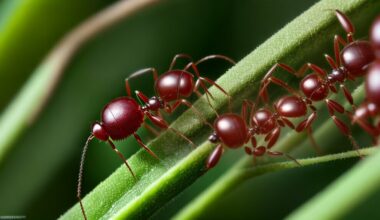If you love growing tomatoes, you know the shock of finding your plants damaged overnight. This leads you to ask what animal eats tomatoes at night? Daytime pests like birds and squirrels are often blamed, but the real culprits are often hidden in the night. These nocturnal animals can be sneaky and clever, making them a challenge to spot.
This guide will reveal the common night pests that target tomatoes, the signs they leave, and how to protect your garden. By the end, you’ll know how to stop these nighttime thieves from eating your tomatoes.
Identifying Nocturnal Tomato Pests
When your tomato plants get damaged at night, it’s time to start investigating. Look for signs and evidence of these nighttime pests. This is the first step to protect your tomatoes.
Clues and Evidence of Night-Time Intruders
Check the details left behind by these pests. Look for ragged leaves, 45-degree cuts on stems, and half-eaten tomatoes. Also, animal tracks or slime trails can be clues. These signs help you figure out who is eating your tomatoes at night.
- Deer and rabbits often eat plants at night and can cause a lot of damage. Deer leave leaves with ragged edges, while rabbits make 45-degree cuts.
- Cutworm caterpillars are a big problem for tomatoes, especially at night. They eat leaves and stems.
- Asiatic garden beetles eat plants at night, leaving big holes around leaf edges.
- Slugs and snails leave slime trails as they eat plants at night.
By looking at the evidence, you can figure out who is damaging your tomatoes at night. Knowing this helps you come up with ways to keep your plants safe.
What Animal Eats Tomatoes at Night
Many animals love tomatoes and sneak into your garden at night to eat. They include common pests and animals that enjoy tomatoes. These creatures can damage your tomatoes, which you worked hard to grow.
Rabbits are one of the main culprits. They eat tomato plants and leave marks on the stems and leaves. Raccoons also eat tomatoes and leave behind trash and half-eaten fruits.
- Deer: Ragged edges on leaves indicate their presence
- Rabbits: Distinctive 45-degree angle cuts on plants
- Raccoons: Half-eaten tomatoes and scattered debris
- Opossums: Feeding on whole tomato fruits
- Skunks: Significant damage to young tomato plants
- Groundhogs: Feeding on tomato plants and burrowing underground
Cutworms, slugs, and snails also attack tomatoes at night. They cut off young plants and leave slime trails. Earwigs, tomato hornworms, voles, mice, and rats can also harm your tomatoes. Each one leaves its own signs of being there.
Knowing about these pests and their signs can help you fight back. By staying alert and taking action, you can save your tomatoes. This way, you can enjoy the fruits of your hard work.
Daytime Tomato Thieves
Daytime pests can be just as troublesome as those at night. Squirrels, chipmunks, and groundhogs love to raid gardens in broad daylight. They snatch ripe tomatoes and leave destruction behind. These pests can make it hard for gardeners to protect their plants.
Birds like crows and sparrows can also damage your tomatoes from above. Insects such as aphids, whiteflies, and spider mites are active during the day too. They weaken plants and cut down on fruit production. You need to keep an eye out for these pests to protect your garden.
Fortunately, these daytime pests are easier to spot. This gives you a chance to stop them and protect your tomatoes. By understanding their behaviors, you can find ways to keep them away. This ensures a good harvest.
There are many ways to keep pests away from your tomatoes. Using hot pepper tea and planting certain plants together can help. Installing wire cages is another option. With these methods, you can reduce damage and enjoy your tomatoes without worry.
The Heartbreak of a Ravaged Tomato Garden
Growing a garden brings joy, but pests can turn that joy into sorrow. Seeing pests destroy your hard work is hard. Many gardeners have felt this pain over the years.
Knowing your garden is part of a bigger ecosystem can help. But, the loss of your tomatoes can still feel overwhelming. It’s a tough feeling for any gardener.
To deal with pests and protect your tomatoes, you need a plan. Using different methods can help lessen the loss and keep pests away.
Growing tomatoes is challenging, but you can succeed with the right methods. Facing the loss can make you stronger. By protecting your garden, you can keep gardening and enjoy your tomatoes.
Raised Beds: No Guarantee of Protection
Tomato lovers often choose raised garden beds or big pots for their plants. These elevated spots are handy, but they don’t keep tomatoes safe from pests. Mice and rats can climb up to get to the ripe tomatoes in these beds.
These pests do more than just eat the tomatoes. They can mess with the soil and harm the roots. This makes the plants stressed and open to bigger animals. Creatures like raccoons, opossums, and groundhogs might also eat your tomatoes.
To keep tomato pests in raised beds away, you need to do more than just raise your plants. Elevating them isn’t enough to stop small rodents or deter small rodents from getting to your tomatoes. You’ll need to use barriers and repellents to protect elevated gardens.
Physical Barriers: A Line of Defense
Protecting your tomato plants from pests can be tough, but the right barriers can help. Using fencing and netting can keep pests away and protect your tomatoes.
Protective Fencing and Netting
Gardening fences can keep out pests like rabbits and rodents. They let your plants get sunlight, air, and water while keeping pests away. But, pests like squirrels can climb over these fences to get to your tomatoes.
To stop this, use fencing and netting together. This way, you create a strong barrier that protects your tomatoes from all sides.
- Tall fencing (at least 6 feet) can keep deer away, which can quickly eat your tomatoes at dawn and dusk.
- Chicken wire or hardware cloth works well against rabbits, who chew on stems and leaves.
- Putting netting around fruit clusters stops squirrels from eating the ripe tomatoes.
- Using bird netting over plants and offering them other food can reduce bird damage to tomatoes.
With these barriers, you can protect your tomatoes from many pests. This ensures a safe and plentiful harvest.
Complementary Solutions for Comprehensive Protection
To keep your tomato garden safe from pests, you need to use many methods together. Physical barriers like fences and nets are key. But, adding other solutions can make your pest control even stronger.
Combining Deterrents for Optimal Defense
Begin by spreading natural repellents like cayenne pepper or strong herbs around your garden. These keep squirrels away because they don’t like the taste. For deer, use tall fences that keep them out. Also you can use deer and rabbit resistant plants around your garden.
Try using predator urine around your garden’s edge too. This smell makes pests want to leave, keeping them away from your tomatoes. It might sound strange, but it works well to protect your garden.
Using different methods together like fences, repellents, and scare tactics helps keep pests away. This way, you make sure your tomatoes are safe and your garden thrives.
Conclusion
Protecting your tomato harvest from pests needs a detailed plan. Knowing the signs pests leave helps you spot the problem and fight it. Using barriers and natural repellents is key to keeping your tomatoes safe.
Using raised beds, fences, and planting certain plants together can help too. These methods boost your chances of a good tomato harvest. By being careful and using different methods, you can reduce pest damage and enjoy your tomatoes.
With hard work and the right methods, your tomato garden will be safe and ready for a great season. Adopting a strong, multi-step plan will help you protect your garden. This way, you can enjoy the delicious tomatoes you’ve grown.





